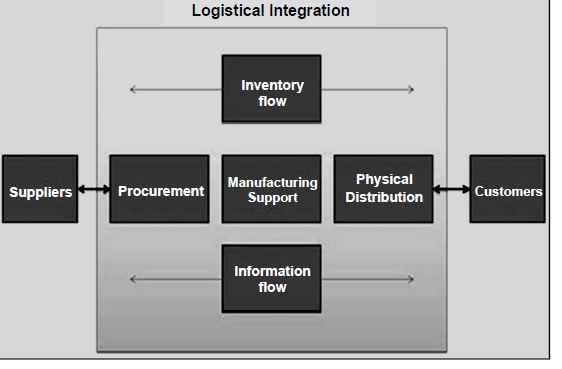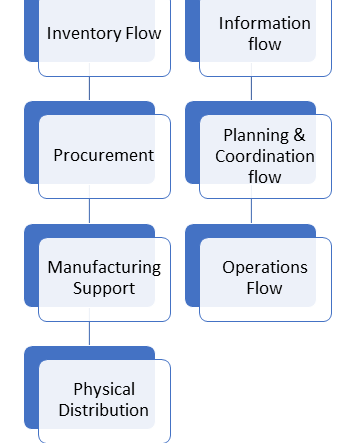Inbound Logistics, inprocess Logistics, Outbound Logistics
- Inbound Logistics is concerned with pre-production activities of logistics i.e. arranging resources and raw materials for further manufacturing. It constitutes Procurement Performance Cycle
- In Process Logistics is production logistics and provides support activities to the manufacturing. It constitutes Manufacturing Performance Cycle.
- Outbound Logistics includes all those activities which are concerned with physical distribution of finished goods from warehouse to the customer. It constitutes physical Distribution Performance Cycle.
Difference between Inbound and Outbound Logistics
Inbound logistics
The inbound logistics process refers to the inflow of raw materials from suppliers to manufacturing plant. This is the first phase of the value chain. It involves various activities, such as the storage and delivery of raw materials and parts that are going to be used in production. It also includes sourcing the materials, tracking inventory and optimizing the movement of products from suppliers to the store, warehouse or manufacturing unit.
Phases
- Supply flow management. This consists of deciding on and managing the product quantities you need as well as the frequency of procurement to ensure the availability of these goods whenever necessary.
- Procurement of stock. This refers to the purchase of the products required by the production and/or sales department. To purchase goods, you need to select a supplier taking into account factors such as price, quality, delivery date, payment terms, etc.
- Transportation planning. Planning for the arrival of goods is paramount for preventing bottlenecks at your warehouse docks. Everyone involved in this stage should be aware of expected orders and their estimated time of arrival.
- Unloading and receipt of material. This relates to the unloading of goods from the trucks and their movement to the receiving or consolidation area. It’s critical to make sure that the products you receive match those you ordered. The package is also checked in this phase to ensure that it is in perfect condition.
- Choice of unit load. Once the goods have been verified and have undergone quality control, they are placed on/in the appropriate unit load pallets, boxes, or containers which will be used to store, transport, and handle the products.
- Product labeling and consolidation. All information relating to the goods received needs to be recorded in order to add the new products to the existing stock in the system, thus updating the inventory status.
- Storage in the ideal system. Goods that have been labeled and are ready to be stored are moved to the storage system best adapted to their characteristics. The products remain there until they are required in the next stage of the supply chain.
Outbound logistics
Outbound logistics involves the flow of finished products from a company to its end customers. These activities are mainly concerned with the distribution channels and customer service. Outbound logistics, as the name indicate, is the collection, storage, and distribution of the final goods and related information flows, from the manufacturing plant to the end user. It covers all those activities (i.e. selecting, packaging, transporting, etc.) which are involved in the outflow of merchandise from seller to the buyer.
Process:
Storage
The storage process depends on a warehouse using the correct methods to keep the finished goods in a safe environment and ensuring they’re easy for staff to access. Because a customer can order a product at any time, effective organization of the warehouse is essential. It can also be more cost-efficient to store as little product as possible because stored goods aren’t earning a profit, and they occupy space the business can use for other purposes.
Transportation
Transportation is the main process of outbound logistics. Logistics depends on transportation, and companies try to move products from one location to another as efficiently as possible while using the most effective methods. Many factors impact transportation, such as:
- Delays
- Fluctuations in fuel prices
- The dependability of the transport team
Components:
Outbound process
There are numerous essential stages that businesses follow in the outbound logistics process. For example, if a sales department receives a customer purchase order, it first checks the inventory to confirm it can fulfill the order. The department then sends this order to the warehouse, where staff find the product and pack it for delivery to the client. The sales team then charges the customer for the order.
Channels of distribution
Many businesses use channels of distribution instead of working directly with the client. A channel of distribution can be an individual or another business that specializes in distribution. For example, a company that manufactures chairs may have a variety of clients in its distribution channels.
These channels may be websites, shops or other vendors, and they’re responsible for promoting, storing and transporting the chairs. A key part of outbound logistics is selecting distributors that promote the product and have a strong delivery network, which can provide greater reliability.
Inventory system
An effective inventory system is essential for ensuring outbound procedures operate efficiently. Businesses often use their past sales and inventory record to predict future demand and make certain they have enough goods to fulfill orders. Having too much or too little product can cause challenges for a business, whereas having the right quantity can increase the order fulfillment rate and raise profits.
Delivery optimization
Optimizing distribution and delivery is another essential component of outbound logistics. A common approach is to use system barcode scanning for inventory tracking. This helps to keep the client updated on the status of the order, and it helps to prevent errors by making them easily identifiable to both the customer and the fulfilling business. Such a process allows the business to meet its delivery deadlines and increase customer satisfaction.
Differences between Inbound and Outbound Logistics
Inbound Logistics refers to the buying, storage, and dispersal, of the incoming goods, to the manufacturing unit. On the other side, outbound logistics implies the transmission, selection, packaging, and distribution of final goods to the end users.
The inbound logistics is aligned towards the usage of resources and raw materials, within the manufacturing or assembly plant. On the contrary, outbound logistics focused on the outflow of final goods or product from the firm to the end customers.
Inbound logistics, is all about sourcing and receiving of raw material and its management, in the organization. Conversely, outbound logistics is mainly deal with customer service and distribution channels.
In inbound logistics, the relationship is between the supplier and the company. Unlike outbound logistics, in which the relationship is between the company and the ultimate customer.




